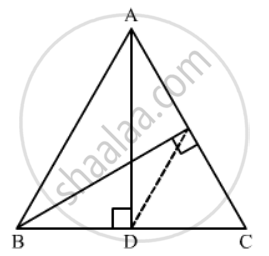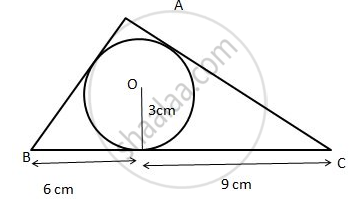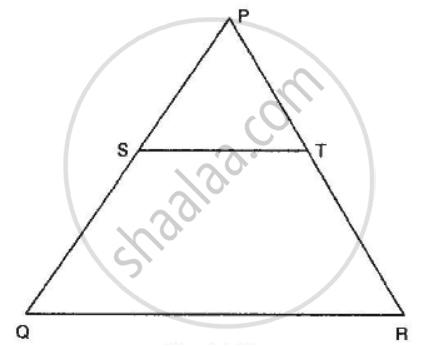Advertisements
Advertisements
Question
In ∆ABC, AD and BE are altitude. Prove that\[\frac{ar\left( ∆ DEC \right)}{ar\left( ∆ ABC \right)} = \frac{{DC}^2}{{AC}^2}\]
Solution
Δ
Given: ΔABC in which AD and BE are altitudes on sides BC and AC respectively.
Since ∠ADB = ∠AEB = 90°, there must be a circle passing through point D and E having AB as diameter.
We also know that, angle in a semi-circle is a right angle.
Now, join DE.
So, ABDE is a cyclic quadrilateral with AB being the diameter of the circle.
∠A + ∠BDE = 180° [Opposite angles in a cyclic quadrilateral are supplementary]
⇒ ∠A + (∠BDA + ∠ADE) = 180°
⇒ ∠BDA + ∠ADE = 180° − ∠A ..... (1)
Again,
∠BDA + ∠ADC = 180° [Linear pair]
⇒ ∠BDA + ∠ADE + ∠EDC = 180°
⇒ ∠BDA + ∠ADE = 180° − ∠EDC ..... (2)
Equating (1) and (2), we get
180° − ∠A = 180° − ∠EDC
⇒ ∠A = ∠EDC
Similarly, ∠B = ∠CED
Now, in ΔABC and ΔDEC, we have
∠A = ∠EDC
∠B = ∠CED
∠C = ∠C
∴ ΔABC ∼ ΔDEC
`⇒ \text{(Area of Δ DEC )}/ \text{(Area of Δ ABC )}= ((DC)/(AC))^2`
APPEARS IN
RELATED QUESTIONS
the below given figure, a triangle ABC is drawn to circumscribe a circle of radius 3 cm, such that the segments BD and DC are respectively of lengths 6 cm and 9 cm. If the area of ΔABC is 54 cm2, then find the lengths of sides AB and AC.
A ladder is placed in such a way that its foot is at a distance of 15m from a wall and its top reaches a window 20m above the ground. Find the length of the ladder.
In each of the figures [(i)-(iv)] given below, a line segment is drawn parallel to one side of the triangle and the lengths of certain line-segment are marked. Find the value of x in each of the following :

In the figure given below DE || BC. If AD = 2.4 cm, DB = 3.6 cm, AC = 5 cm. Find AE.
In the given figure, S and T are points on the sides PQ and PR respectively of ∆PQR such that PT = 2 cm, TR = 4 cm and ST is parallel to QR. Find the ratio of the areas of ∆PST and ∆PQR.

If D, E, F are the mid-points of sides BC, CA and AB respectively of ∆ABC, then the ratio of the areas of triangles DEF and ABC is
∆ABC ∼ ∆DEF, ar(∆ABC) = 9 cm2, ar(∆DEF) = 16 cm2. If BC = 2.1 cm, then the measure of EF is
∆ABC ∼ ∆PQR such that ar(∆ABC) = 4 ar(∆PQR). If BC = 12 cm, then QR =
In a ∆ABC, perpendicular AD from A and BC meets BC at D. If BD = 8 cm, DC = 2 cm and AD = 4 cm, then
∆ABC is such that AB = 3cm, BC = 2cm, CA = 2.5cm. If ∆ABC ~ ∆DEF and EF = 4cm, then perimeter of ∆DEF is ______.
